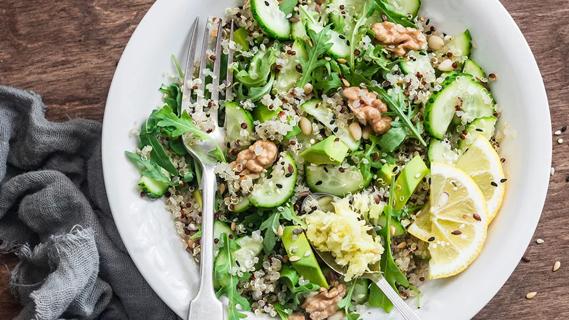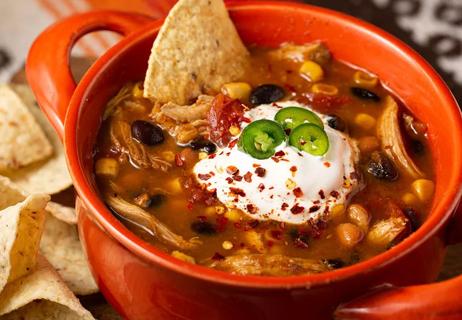Following a healthy diet can boost your well-being

If you have Parkinson’s disease (PD), you may be overwhelmed by diet advice. Some sources may tell you to eat certain foods and avoid others. Some may even claim that specific foods are miracle cures for your symptoms. How do you know what to believe?
Advertisement
Cleveland Clinic is a non-profit academic medical center. Advertising on our site helps support our mission. We do not endorse non-Cleveland Clinic products or services. Policy
Neurologist Michal Gostkowski, DO, says some information about PD and foods is based on outdated or inaccurate research — or it may not have any science to back it up.
But there is some solid advice when it comes to your diet. Dr. Gostkowski explains what you should know about the foods you eat.
Fava beans contain an amino acid known as levodopa. Levodopa is an active ingredient in some Parkinson’s medications. Seems like a good reason to eat a lot of fava beans, right?
Nope. Dr. Gostkowski explains that the amount in the beans is tiny compared to what’s in your medication. “You can’t eat enough fava beans to have any effect on your symptoms,” he says.
Bananas also have levodopa in them, Dr. Gostkowski says. But, like fava beans, it’s not possible to eat enough bananas to affect PD symptoms. Of course, if you like fava beans or bananas, enjoy! But don’t go overboard or expect them to work like medication. Eat a variety of fruits, veggies, legumes and whole grains for balance.
If you’re taking a levodopa medication, your doctor may tell you to avoid protein when taking your meds. Both animal and plant protein can interfere with the absorption of levodopa medications.
But you should still eat plenty of protein. Just be strategic with the timing. “Don’t take levodopa medications with meals,” Dr. Gostkowski says. “It’s best to take it on an empty stomach — either 30 minutes before your meal or an hour after eating.”
Advertisement
If you get nauseous from the medication, eat a small amount of starchy food with it, such as crackers. Make sure whatever you eat with your medicine doesn’t have protein. “It’s a misunderstanding that people with Parkinson’s should avoid protein,” Dr. Gostkowski says. “You definitely need protein in your diet. Just don’t eat it when you’re taking your levodopa medication.”
A high-fiber diet is a proven way to avoid constipation, a common problem for people with PD.
“Parkinson’s can slow down the intestines and cause constipation,” Dr. Gostkowski says. “Fiber helps keep things moving.” There are plenty of high-fiber foods out there, so choose your favorites. Women should aim for 25 grams of fiber per day, and men should get 38 grams.
Fiber alone will not solve a constipation problem, Dr. Gostkowski says. Drinking plenty of water is essential.
“Drink several glasses of water each day,” he says. “Constipation is worse when there isn’t enough water in the bowels.”
And focus on pure water, not other beverages. “Fluids like coffee or sports drinks are not equal to water. Drink six to eight glasses of water a day, with nothing added to it.”
Dr. Gostkowski understands that this is often easier said than done. “Many people who have Parkinson’s avoid drinking water because they have trouble getting to the bathroom,” he says.
To help avoid this challenge, Dr. Gostkowski recommends:
Most of today’s health advice says to cut back on salt. A high-sodium diet can cause high blood pressure, a potentially serious condition.
But PD can cause the opposite problem in some cases. “Many people with Parkinson’s have orthostatic hypotension,” Dr. Gostkowski says. “This drop in blood pressure happens when you get up from sitting or lying down. The heart and blood vessels don’t respond as quickly as they should, causing you to get lightheaded or pass out. You can fall and get injured.”
Eating more salt can help with orthostatic hypotension. But don’t fill your diet with processed foods like French fries. Instead, add salt to nutrient-rich foods like vegetables and whole grains. And ask your doctor before you start eating more salt. If you don’t have orthostatic hypotension, you may need to limit sodium to no more than 2,300 milligrams per day.
Dr. Gostkowski says if you want to feel your best, combine a healthy diet with exercise. Research has shown that regular exercise can improve PD symptoms.
Advertisement
“Do exercise that raises your heart rate,” Dr. Gostkowski says. “Aim for about 30 minutes a day, five days a week.” Don’t worry about specific exercises. Do an activity you enjoy, as long as it gets your heart rate up. Try brisk walking or biking or more advanced exercise for veteran athletes. “I recommend seeing an occupational therapist. They can tailor an exercise program to your needs.”
Diet and exercise are important for managing PD, but don’t forget about medications. Take them regularly and exactly as your doctor prescribes.
If you tend to forget your medication, set an alarm to remind you. You can also use a pillbox that’s labeled with days and times of day. “Take your meds on a set schedule, don’t skip doses and don’t double dose,” says Dr. Gostkowski. “When you’re diligent about taking your medications and following a healthy lifestyle, you’ll feel your best.”
Advertisement
Learn more about our editorial process.
Advertisement

When it comes to getting proper nutrition, your assigned sex can play a role — but there’s more to it than that

Ground flaxseed is full of heart-healthy omega-3s, antioxidants and fiber, and easy to add to just about any recipe

From meat to beans, we’ve got some ideas to help you create the perfect-for-you chili recipe

Only 130 calories per serving, this dessert deserves your attention

Plan ahead, bring a cooler when possible and don’t forget the water!

A delicious twist on grilling

A cool, refreshing and satisfying salad!

Type 2 diabetes isn’t inevitable with these dietary changes

Applying a hot or cold compress can help with pain